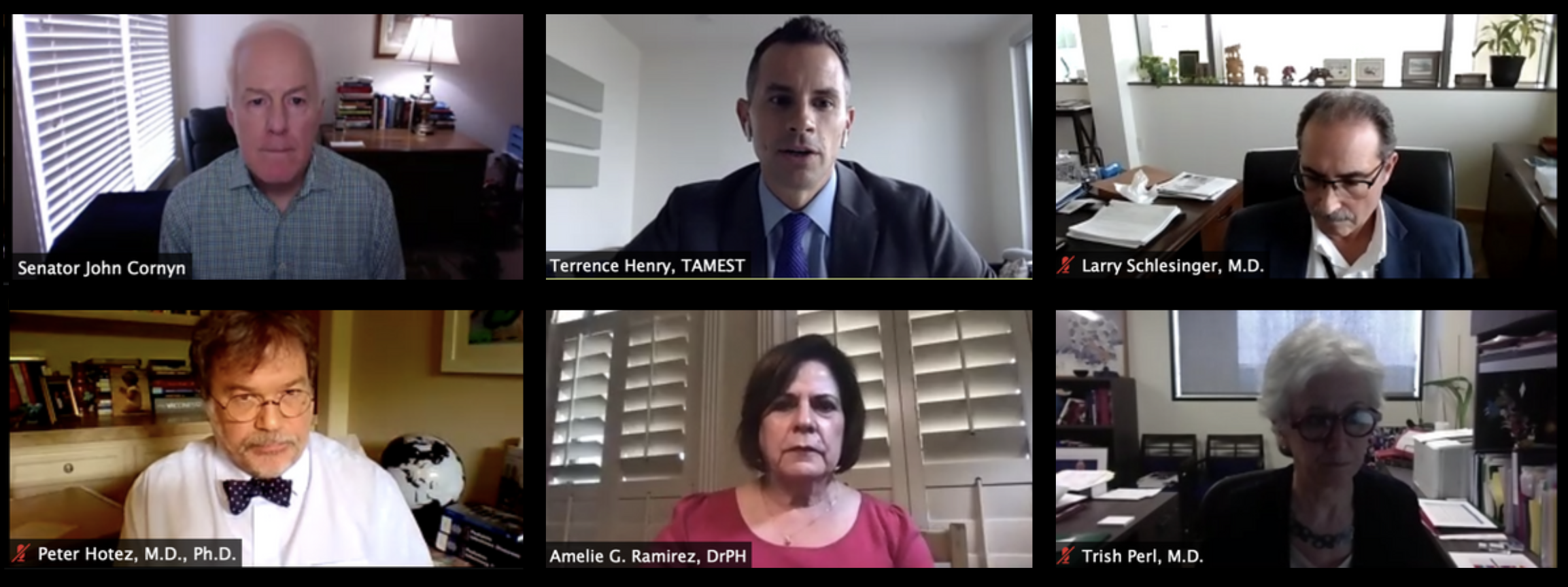United States Senator John Cornyn and TAMEST Convene Texas Academic and Industry Leaders for Conversation on COVID-19

TAMEST (The Academy of Medicine, Engineering and Science of Texas) hosted a virtual conversation on COVID-19 with United States Senator John Cornyn and Texas research leaders on Thursday, April 9, 2020.
TAMEST member institution chancellors, presidents, vice presidents of research, provosts and schools of medicine deans attended the virtual meeting to learn more about the Congressional response to the COVID-19 pandemic, including three bills recently passed that support universities and health care facilities in their efforts against the virus.
The current state of COVID-19 in Texas including its estimated peak, timetables for vaccines, risk factors for transmission and spotlights on current research being done in the state were also discussed.
Senator Cornyn described three pieces of recently passed bipartisan legislation, which will increase COVID-19 testing, expand unemployment insurance and provide other necessary resources for individuals and businesses to help “weather the storm.”
“Congress has delivered targeted relief for Texans needing a lifeline, and this call gave me the opportunity to let TAMEST’s member institutions know what we’ve done to help them beat the coronavirus,” Senator Cornyn said.
Senator Cornyn stressed the need for Texas’ academic research and health care communities during this time and said health care provisions, emergency student funding and National Institutes of Health (NIH) funding for competitive research grants are all included in the federal response.
Speakers on the call included TAMEST Member Peter J. Hotez, M.D., Ph.D. (National Academy of Medicine), Dean for the National School of Tropical Medicine, Baylor College of Medicine in Houston; Trish M. Perl, M.D., M.Sc., Chief, Division of Infectious Diseases and Geographic Medicine, UT Southwestern Medical Center; and Larry Schlesinger, M.D., President and CEO, Texas Biomedical Research Institute.
Dr. Hotez is currently working on a vaccine his team designed for the SARS outbreak in the early 2000s through his work at Baylor College of Medicine. He discussed the current models for how long the pandemic could last and stressed that vaccines take time to create.
While people are eager for stay-at-home and shelter-in-place orders to end, Dr. Hotez said it is time to start planning for the long term as continued spikes of the virus are anticipated in the coming months and years until a vaccine is developed and approved.
“I think that is going to be a real challenge for us as we think about how we will operate in the state of Texas…maybe the stars will align and we will get [a vaccine] in 12–18 months, but I think we have to be realistic about the possibility that this could be around for 2–3 more years,” Dr. Hotez said. “Realizing things won’t be in shutdown mode for two to three years, that things will go up and down [and more rounds of social distancing may be required], I think this could be a very important role for TAMEST because it is so complicated and inter-disciplinary. Bringing in experts from the business sector, the legal sector, etc. will really help look at how we manage this.”
Dr. Perl, an infectious disease expert from UT Southwestern Medical Center, spoke on risk factors and demographics. While it started out as a travel-related virus, it is now spread by close contact and she discussed how those with underlying health issues as well as older adults are at high risk for infection.
She said the biggest risk factors in health care settings are general fatigue, lack of Personal Protective Equipment (PPE) and procedures that require close contact with the face and mouth.
“All and all what we can say about this is that this is a respiratory virus, it is transmitted by close contact…and in health care this can clearly be very devastating, in terms of its ability to spread,” Dr. Perl said. “Just cleaning your hands and washing your hands frequently will decrease your chance of infection by almost 50 percent, and if you look at the individual components of additionally using PPE (wearing a mask, an N95 respirator, gloves and gowns), each of these alone significantly decrease the risk.”
The meeting ended with an example of what the research industry in Texas is doing to help mitigate impacts of the pandemic and better understand the virus. In San Antonio, Texas Biomedical Research Institute (TBRI) is currently working on five separate research projects to help develop safe vaccines and antiviral medication to combat COVID-19.
From diagnostics to in vitro testing and animal model studies, to eventual human clinical trials, TBRI’s President and CEO spoke about their collaborations with other institutions across the state to stop COVID-19’s progression.
“This current COVID-19 pandemic underscores the importance of Texas Biomedical Research Institute’s mission, and we quickly galvanized our scientific community to be engaged in the race for cures and approaches,” President Schlesinger said. “We are capitalizing on our strengths, which is our strength in virology, and we brought together a team of six scientists and thirty staff to go all in on COVID-19.”
For TAMEST’s list of what specific Texas research institutions are doing to mitigate the impact of COVID-19 click here.
About TAMEST (The Academy of Medicine, Engineering and Science of Texas
TAMEST was co-founded in 2004 by the Honorable Kay Bailey Hutchison and Nobel Laureates Michael S. Brown, M.D., and Richard E. Smalley, Ph.D. With more than 300 members and 18 member institutions, TAMEST is composed of the Texas-based members of the three National Academies (National Academy of Medicine, National Academy of Engineering and National Academy of Sciences), the Royal Society and the state’s 11 Nobel Laureates. We bring together the state’s brightest minds in medicine, engineering, science and technology to foster collaboration, and to advance research, innovation and business in Texas. TAMEST’s unique interdisciplinary model has become an effective recruitment tool for top research and development centers across Texas. Since our founding, more than 224 TAMEST members have been inducted into the National Academies or relocated to Texas.

